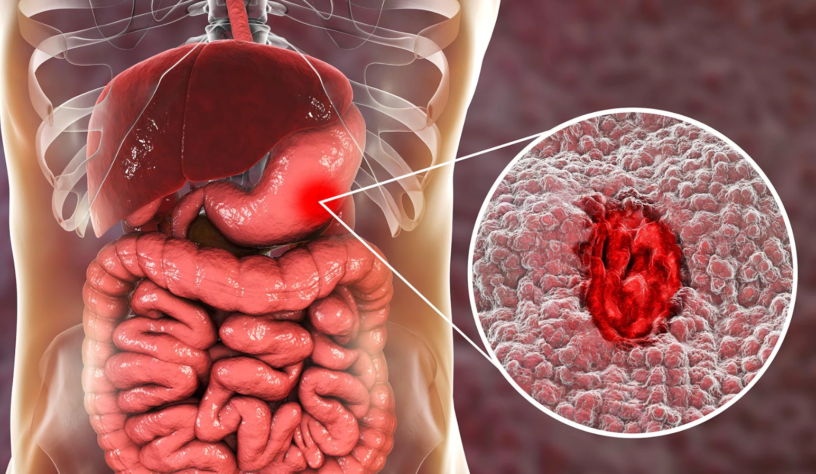By definition, an ulcer is erosion on any bodily surface—the skin or the mucous membranes that line hollow organs. When people use the word, they’re usually referring to peptic ulcers, in which case the craterlike sores occur in the stomach or duodenum (first part of the small intestine). However, ulcers can occur anywhere along the gastrointestinal tract, from mouth to anus. These small, but painful sores usually heal within seven to ten days. Genetic vulnerability seems to play a role. Triggers include food allergies, stress, smoking, trauma (from braces, dentures, hot foods, or hard toothbrushes), certain medications, toothpaste containing sodium lauryl sulfate, and nutrient deficiencies (vitamin C, vitamin B12, folic acid, and iron).


1. Cabbage Juice Relief
How it works: In the 1950s, Cheney and colleagues conducted a study on San Quentin Prison inmates that demonstrated improved healing of peptic ulcers from concentrated cabbage juice relative to a placebo beverage. Volunteers received 50 milliliters (just under 2 ounces, or ¼ cup) a day for twenty-one days. Later research showed that the fresh juice of white cabbage stimulates the immune system and contains glutamine, an amino acid that may improve the stomach’s protective lining.
- PREPARATION:
- ½ head white cabbage washed and chopped coarsely (no hearts)
- About 2 cups (475 ml) water
- DIRECTIONS: Fill a blender with the cabbage. Add water to the two-thirds mark. Blend on high speed until fully blended, about a minute. Strain or press the mixture. (A medium-size French press works well to strain out the juice.) Drink ½ cup (120 ml) up to three times a day. Store the unused portion in the refrigerator. Discard after twenty-four hours.
- YIELD: 12 OUNCES (355 ML) CABBAGE JUICE
- NOTE: If you have a juicer, you can simply juice a white cabbage.
2. Breakfast Boost
How it works: A bacterium common in fermented dairy products (Lactobacillus acidophilus) produces fatty acids that suppress H. pylori. In test-tube studies, cranberry extract and honey inhibit H. pylori.
- PREPARATION:
- 1 large banana, frozen and sliced
- 1 cup (255 g) frozen sliced strawberries
- 1 cup (230 g) vanilla yogurt
- 3 tablespoons (36 g) psyllium powder
- 1 to 2 cups (235 to 475 ml) cranberry or cranapple juice
- DIRECTIONS: In a blender, blend together the bananas, strawberries, and yogurt. Blend in the psyllium powder. Add the juice to your desired consistency and amount.
- YIELD: 2 SERVINGS
3. Wrap-It-Up Fish
How it works: Some polyunsaturated fatty acids, including the kind in fish oil, evening primrose oil, flaxseed oil, and black currant seed oil, are anti-inflammatory and inhibit H. pylori. A type of fatty acid prominent in oily fish, such as salmon, may be particularly helpful. In test-tube studies, garlic inhibits H. pylori.
- PREPARATION:
- 2 long sheets (about 13 x 18-inches [33 x 45.5 cm]) phyllo pastry
- 1 tablespoon (15 ml) olive oil
- ½ zucchini, chopped
- 8 broccoli florets, halved
- 1 garlic clove, minced
- 1 salmon fillet (8 ounces, or 225 g), skin removed
- 1 tablespoon (10 ml) vegetable stock
- 1 teaspoon (10 g) chopped dill
- DIRECTIONS:
Preheat the oven to 350°F (180°C, or gas mark 4).
Lightly spray a large baking sheet with cooking spray. Spread out one phyllo sheet on the prepared baking sheet. Lightly brush the phyllo sheet with olive oil. Place the second sheet on top of the first and lightly brush with olive oil. Cover the top layer of phyllo with a layer of zucchini and broccoli. Sprinkle with garlic. Lay the salmon on top. Spoon the vegetable stock over the salmon. Sprinkle the dill on top. Fold up the phyllo pastry, envelope style, to cover the salmon and pinch together the edges. Lightly brush the outside of the packet with olive oil. Bake for 20 minutes.
- YIELD: 2 SERVINGS
4. Mouth Ulcer Paste
How it works: The baking soda paste covers the sore to protect it from irritants. The Mayo Clinic recommends this mixture to ease pain and help to heal. Alternate: For a quick rinse, mix 1 cup (235 ml) of warm water, ¼ teaspoon of baking soda, and ¹∕8 teaspoons of salt. Rinse several times a day using a new batch each time. Then rinse with a plain cup (235 ml) of water.
- PREPARATION:
- 1 teaspoon (5 g) baking soda
- Water
- DIRECTIONS: In a small, clean dish, mix together the baking soda and as much water as needed to form a paste. With a cotton swab, apply each sore to your desired thickness. Create a fresh batch and apply it three times a day.
- YIELD: 1 APPLICATION
5. Slippery Elm Mouth Ulcer Relief
How it works: Aloe vera gel decreases inflammation, stimulates the immune system, and enhances wound healing. Preliminary studies show that topical aloe gel decreases the pain of aphthous ulcers and speeds healing. The inner bark of slippery elm (Ulmus rubra) contains mucilaginous substances that coat and soothe irritated membranes.
- PREPARATION:
- 1 tablespoon (15 g) Aloe vera gel
- 1 teaspoon (5 g) powdered slippery elm bark
- DIRECTIONS: Put both ingredients in a small, clean jar and blend with a chopstick. Dot on mouth ulcers as needed. Cap the jar when not in use.
- YIELD: MULTIPLE APPLICATIONS
- NOTE: Use either 99 percent aloe gel or fresh Aloe gel gently scraped from the inner leaf of an Aloe Vera plant (we recommend growing one in an indoor pot). You can find powdered slippery elm bark at natural food stores and herb retailers.
6. Aloe Minty Ulcer Relief
How it works: As noted earlier, preliminary research suggests that aloe gel reduces mouth ulcer discomfort and hastens to heal. Applied topically, the menthol in peppermint essential oil decreases pain.
- PREPARATION:
- 1 tablespoon (15 g) 99 percent Aloe Vera gel
- 1 drop peppermint essential oil
- DIRECTIONS: Put the aloe gel in a small, clean jar. Add 1 drop of peppermint essential oil. Blend with a chopstick. Cap tightly. Using a clean finger, dot on mouth ulcers as needed.
- YIELD: MULTIPLE APPLICATIONS
- NOTE: Alternatively, cut off the end of a leaf from a fresh Aloe vera plant. Slice the piece lengthwise. Scoop out a little gel with your finger and dot directly on mouth ulcers.
7. Positively Pleasing Ulcer Potion
How it works: In test-tube studies, chamomile and sage inhibit H. pylori. Cranberry and honey are inhibitors as well. Animal studies indicate that ginger reduces the concentration of H. pylori and inflammation in the stomach and protects against stress-induced ulcers. Whether these plants are similarly helpful in humans isn’t yet known. However, they all have other health benefits and taste great.
- PREPARATION:
- 6 cups (1.4 L) water
- ¼ cup (25 g) fresh ginger slices
- 6 chamomile tea bags
- 1 tablespoon (3 g) chopped fresh sage
- 3 cups (700 ml) pure cranberry juice
- Honey (optional)
- DIRECTIONS: Boil the water in a large pot. Add the ginger, tea bags, and sage; steep for 10 minutes. Strain into a pitcher. Stir in the juice. Add honey, if desired. Drink throughout the day.
- YIELD: 8 SERVINGS
Fact or Myth?
- COFFEE CAUSES ULCERS. That’s a controversial issue. Although coffee and other caffeine-containing beverages stimulate the secretion of stomach acid, they don’t seem to cause ulcers. Furthermore, decaffeinated coffee also releases stomach acid. Nevertheless, if coffee worsens your symptoms or your doctor recommends you quit, follow that advice.
Lifestyle Tip
- Exercise. Although extreme exercise can increase the risk of gastritis and peptic ulcers, moderate, regular physical activity has a protective effect on the gut and also relieves stress. A bit of advice: Wait a good 30 minutes after eating before you engage in aerobic exercise to allow your food to digest.
- For mouth ulcers, make a solution that’s half water and half hydrogen peroxide. Dab the solution onto the sore. Next coat the area with milk of magnesia. Repeat three or four times a day. Medlineplus, the National Library of Medicine’s website for consumer health information, recommends this remedy for soothing relief.
- Find ways to reduce your stress load. Preliminary research shows that stress management reduces symptoms of peptic ulcer disease and improves the quality of life for people with inflammatory bowel disease. Stress-reducing therapies include psychotherapy, biofeedback, relaxation breathing, mindfulness-based meditation, guided imagery, tai chi, qigong, and yoga.
- Get enough sleep. Chronic sleep deprivation raises your risk of peptic ulcer disease and worsens inflammatory bowel disease.
- Stay away from tobacco. Tobacco decreases blood flow to the gut, worsening ulcerative conditions.
When to Call the Doctor
- You suspect you have gastritis, peptic ulcer, or inflammatory bowel disease.
- You notice black stools (and are not taking iron supplements).
- You have already been diagnosed with an ulcer and have recurrent symptoms.
- You have bright red blood in your stool (not related to hemorrhoids).
- You vomit blood (old blood can have a coffee-grounds appearance).
- You have severe abdominal pain.






Leave a Reply